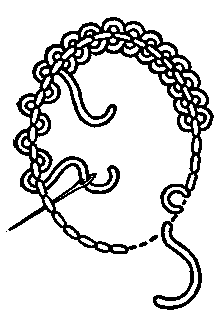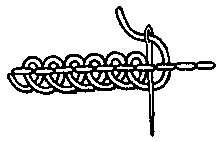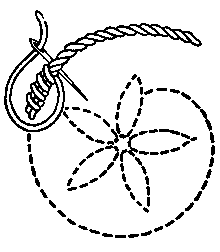Backstitch or back stitch and its variants stem stitch, outline stitch and split stitch are a class of embroidery and sewing stitches in which individual stitches are made backward to the general direction of sewing. These stitches form lines and are most often used to outline shapes or to add fine detail to an embroidered picture.
Contents[hide] |
[edit] Applications
Basic backstitch is used to outline shapes in modern cross-stitch, in Assisi embroidery and occasionally in blackwork.
A versatile and easy to work stitch, backstitch is ideal for following both smooth and complicated outlines and as a foundation row for more complex embroidery stitches such as Herringbone ladder filling stitch. Although superficially similar to Holbein stitch, commonly used in Blackwork embroidery, backstitch differs in the way it is worked, requiring a single journey only to complete a line of stitching.
Stem stitch is an ancient technique; surviving mantles embroidered with stem stitch by the Paracas people of Peru are dated to the first century BCE.[1] Stem stitch is used in the Bayeux Tapestry, an embroidered cloth probably dating to the later 1070s, for lettering and to outline areas filled with couching or laid-work.[2]
Split stitch in silk is characteristic of Opus Anglicanum, an embroidery style of Medieval England.[2]
[edit] Description of the technique
Backstitch is most easily worked on an even-weave fabric, where the threads can be counted to ensure regularity, and is generally executed from right to left. The stitches are worked in a 'two steps forward, one step back' fashion, along the line to be filled, as shown in the diagram.
Neatly worked in a straight line this stitch resembles machine stitching.
The back stitch can also be used as a hand-sewing sewing utility stitch to attach two pieces of fabric together.
[edit] Variants
Variants of backstitch include:
- Basic backstitch or point de sable.
- Threaded backstitch
- Pekinese stitch, a looped interlaced backstitch
- Stem stitch, in which each stitch overlaps the previous stitch to one side, forming a twisted line of stitching, with the thread passing below the needle. It is generally used for outlining shapes and for stitching flower stems[3] and tendrils.
- Whipped stem stitch
- Outline stitch, sometimes distinguished from stem stitch in that the thread passes above rather than below the needle.
- Split stitch, in which the needle pierces the thread rather than returning to one side.






No comments:
Post a Comment